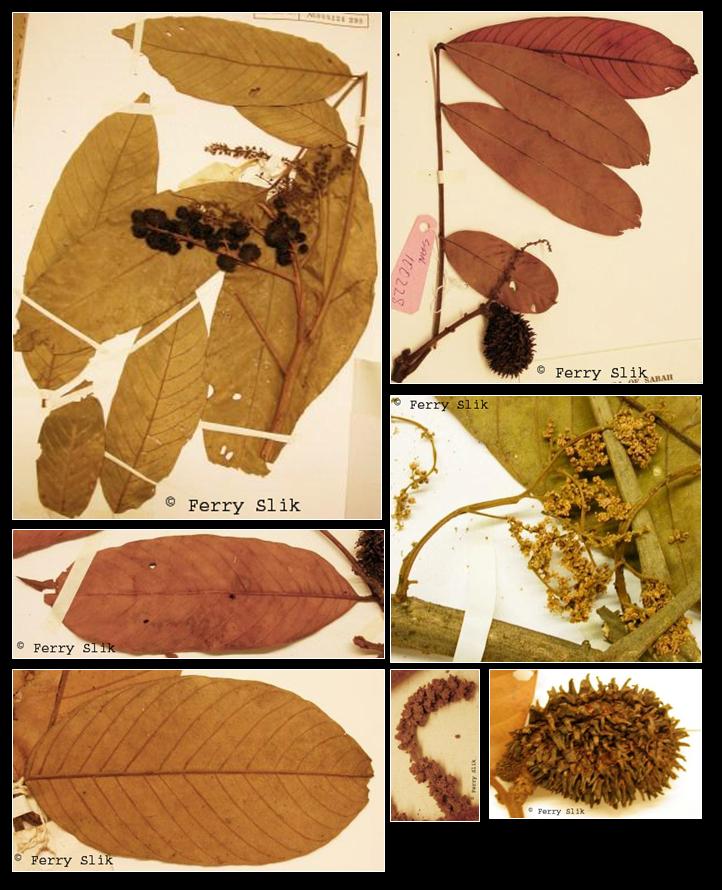Nephelium cuspidatum Blume, Rumphia 3 (1847)
Latin for 'pointed'.Synonyms
Nephelium bassacense Pierre
Nephelium beccarianum Radlk.
Nephelium dasyneurum Radlk.
Nephelium eriopetalum Miq.
Nephelium multinerve Radlk.
Nephelium obliquinervis Radlk.
Nephelium ophiodes Radlk.
Nephelium robustum Radlk.
Diagnostics
Mid-canopy tree up to 35(-40) m tall and 69(-80) cm dbh. Stipules absent. Leaves
alternate, compound, leaflets penni-veined, almost glabrous to densely hairy,
sometimes whitish below. Flowers ca. 5 mm diameter, white-yellowish-red, placed
in panicles. Fruits ca. 33 mm long, green-red, soft spiny drupes. Seeds with
aril.
Description
Tree, up to 40 m high, dbh up to 80 cm, sometimes
with small buttresses, rarely a shrub. Twigs
2.5-15 mm in diam., tomentellous, tomentose, or
velvety, mostly only late glabrescent. Leaves (1-)
2-9(-13)-jugate; petiole 2.5-21 cm long, 1-6 mm
thick, terete to semiterete, in the latter case sometimes
above with a longitudinal groove; axes mostly
long remaining hairy; petiolules 2-7.5(-15) mm
long, above variably grooved or somefimes flat,
with or without a median rib. Leaflets (narrowly)
elliptic, 6-35 by 1.8-12.5 cm, index 1.5-5, coriaceous
or chartaceous, above glabrous to variably
hairy along the midrib and on the lower nerves,
rarely all over the surface, beneath variably hairy
all over, between the nerves often minutely sericeous;
domatia absent; base acute to broadly rounded,
exceptionally subcordate, mostly variably attenuate;
sides curved to straight and parallel; apex
rounded to acute, mostly acuminate, the acumen
up to 2.5 cm long, slender to sometimes broad,
acute to sometimes obtuse; midrib above sunken
to prominulous, nerves 0.5-2 cm apart, above
prominulous to slightly grooved, intercalated veins
variably developed, veins and veinlets either together
closely or sometimes laxly reticulate, or the
former +/- clearly scalariform, at least the veinlets
beneath often hardly visible. Inflorescences most
ly in the upper leaf axils, together pseudoterminal,
sometimes terminal, also rami- or cauliflorous,
often long pendulous racemes or spikes. Sepals
hardly to up to halfway connate, 1.1-2.5 mm long.
Petals mostly absent, if present often reduced in
number. Disc hairy or glabrous. Stamens (4-)7 or
8 (or 9). Ovary 2-celled. Fruits ellipsoid to sometimes
globular, 2-4 by 2-3 cm, glabrous or sometimes
slightly hairy at the tip of the appendages,
mostly densely set with appendages, those filiform
to narrowly strap-shaped and up to 2 cm long, or
sometimes ligulate and 5-6 mm long, straight or
often curved or curled, at base globular, pyramidal,
or triangular and in the latter case often connate;
wall coriaceous, thin. [from Flora Malesiana]
Ecology
In undisturbed to slightly disturbed (open sites) mixed dipterocarp forests
up to 800 m altitude. Along rivers and streams and on hillsides with sandy to
clay soils, but also on limestone.
Uses
The wood is locally used for construction work. The trees are often
cultivated in forest gardens for their edible fruits.
Distribution
Burma, Indo-China, Thailand, Peninsular Malaysia, Sumatra, Java, Borneo, Philippines.
Local names
Borneo: Bayong, Buah senkelang, Kachay, Kalambuko, Lok, Mengalim, Parot, Rambutan,
Rugutuloh.
